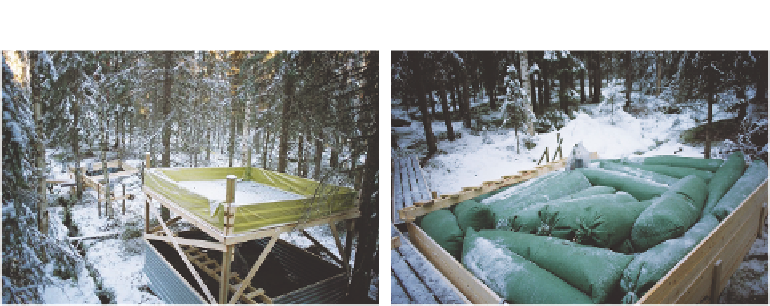Geoscience Reference
In-Depth Information
(a)
(b)
Figure 3.13
Experimental design - (a) deep frost plot and (b) shallow frost plot.
(Photographs by Peder Blomkvist.)
The effect of soil frost and snow cover on DOC in surface
waters - a manipulation experiment in northern Sweden
Snow cover in northern regions provides a major fraction of the annual water
budget, and it plays a fundamental role in regulating the winter biogeochemistry
of soils in northern forests (Groffman
et al
. 2001). Snow cover limits or even
prevents the development of soil frost. Changes in the timing, extent and
duration of the snow cover, as projected under a future warmer climate, may
result in an increased number of freeze-thaw events, or longer snow-free periods
during winter (Stieglitz
et al
. 2003; Mellander
et al
. 2007). As DOC in some
streams is strongly controlled by soil solution chemistry in the riparian zone,
changes here could alter both quantity and bioavailability of DOC exported to
the adjacent streams during the spring flood - up to half of the annual runoff
and DOC flux may occur during snow melt in small streams and rivers in
northern Sweden (Ågren
et al
. 2007). Moreover, many boreal surface waters
experience a pH decline of one to two pH units during snow melt, driven
primarily by a transient increase in DOC export from the terrestrial systems
(Buffam
et al
. 2007).
The multi-year field manipulation experiment at the Svartberget Research
Station in northern Sweden, initiated in 2002, was designed to study the effect of
changed winter temperature on DOC in riparian soils. Soil frost was manipulated
by insulation to prevent below-ground freezing (shallow frost plot) and by
delaying snow accumulation by 3 months to increase soil frost (deep frost plot)
and was compared with natural conditions (control plot) (Fig. 3.13).
Delaying winter snow cover by 3 months also delayed soil warming well into
July. As a consequence, DOC concentration in the previously frozen soil layers
was clearly increased, compared with the unfrozen reference plots, with a soil-
frost-induced doubling of DOC in the uppermost soil horizons during late spring
and early summer (Fig. 3.14). Soil frost also seemed to have affected DOC
characteristics, measured as changes in the overall shape of the absorption
spectrum, which were interpreted as suggesting that the bioavailability of organic
matter increased after freezing (Berggren
et al
. 2007).




























Search WWH ::

Custom Search